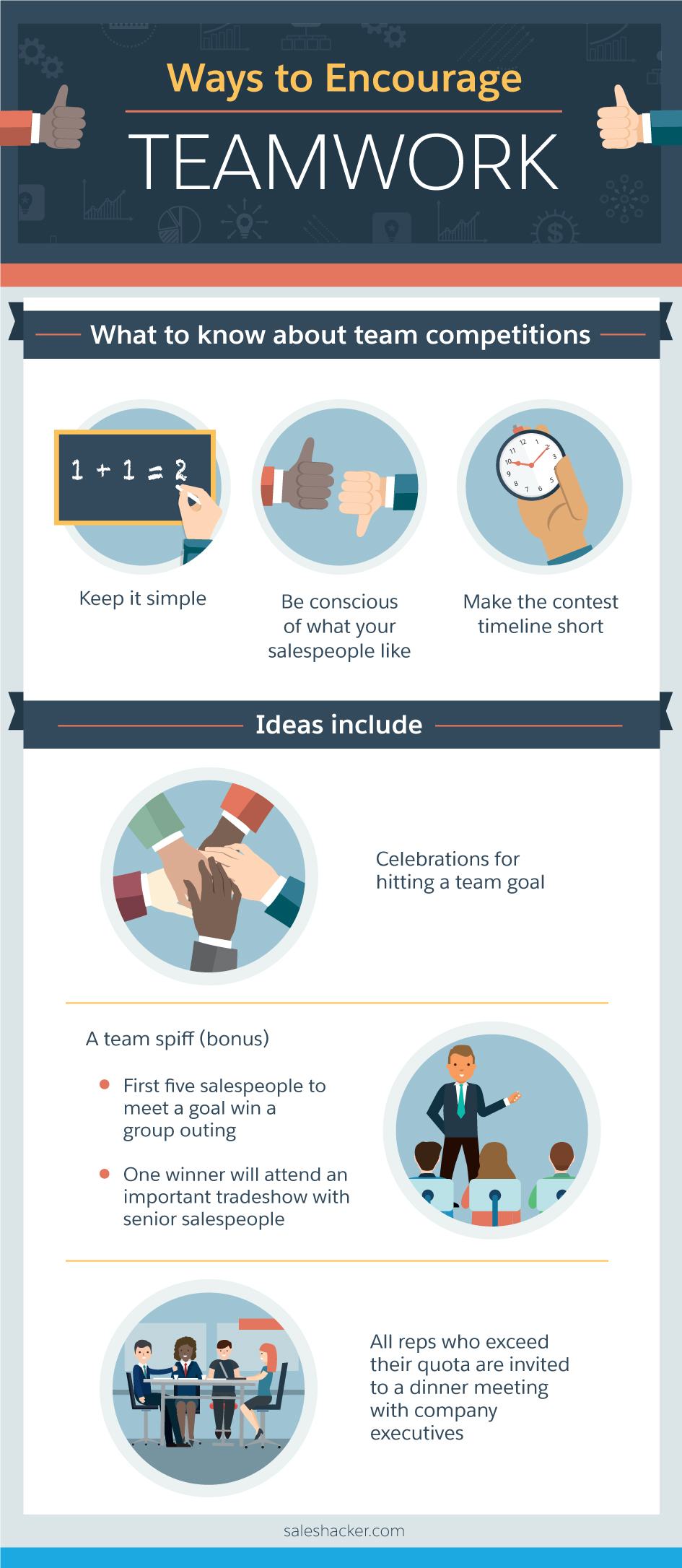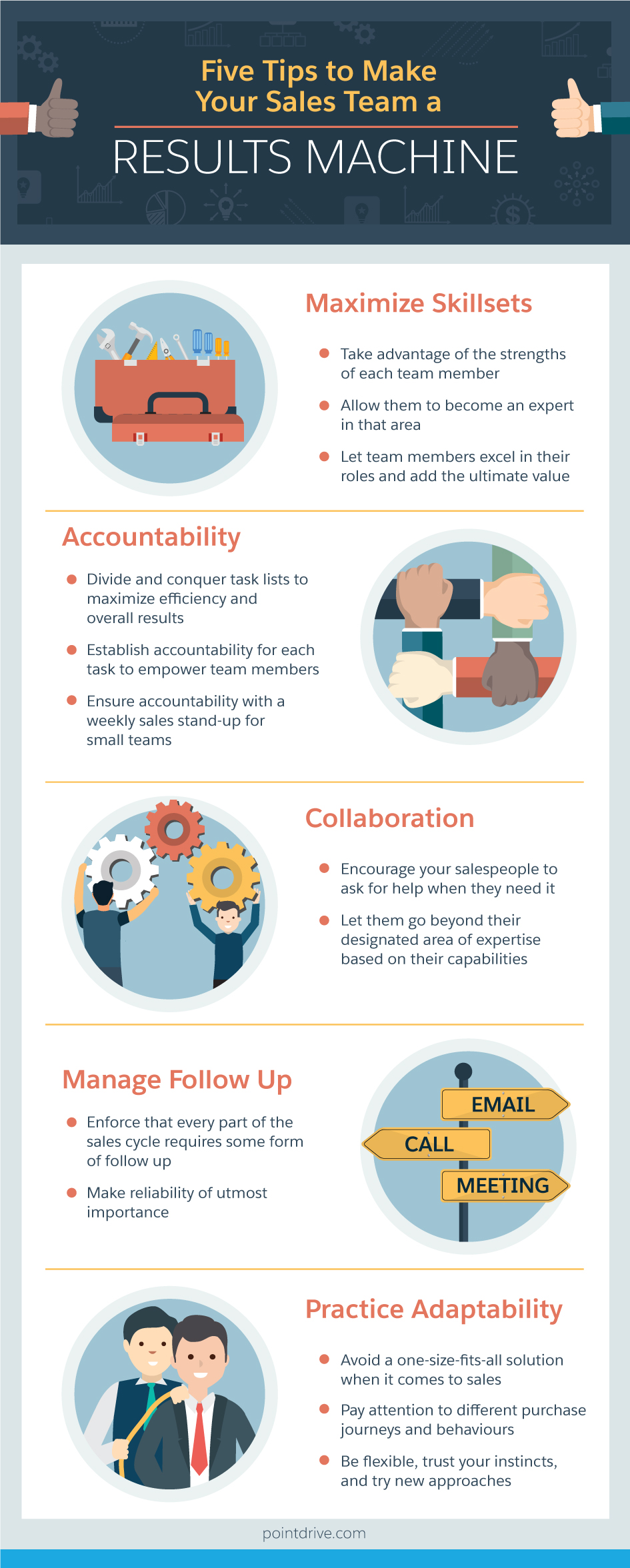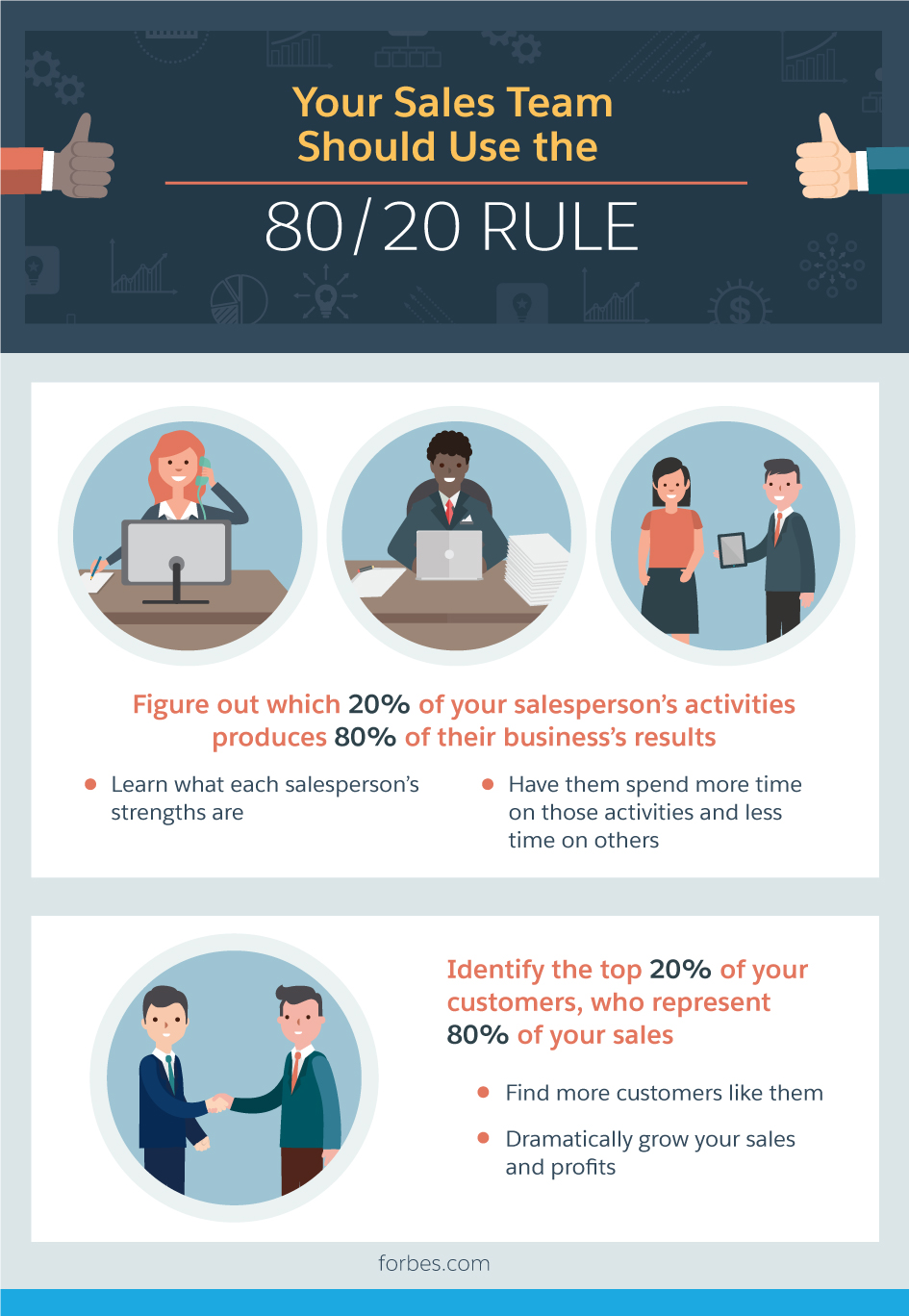How to Build a Sales Team that Successfully Competes Together



Unity within your sales department is important, but so is a healthy dose of competition. Here's how to achieve both.
Danny Wong
The best sales teams operate like a well-oiled machine: Business development reps act as the ball bearings, inside salespeople function as the gears. Sales managers fulfill the role of the carriage, supporting their team through each stage of the process. All of the moving parts work together to produce smooth and effective results.
Traditional sales organizations typically place emphasis on individual performance; however, this approach has its limitations. This can create competition between reps, which can turn co-worker relationships toxic as a salesperson may encroach on another’s territory. In rare cases, a sales rep may take the competition too far and impact a colleague’s deal.
Alternatively, when salespeople cooperate and compete together, rather than against each other, they make a larger impact on their company’s bottom line. In this article, we describe six ways leadership can build a sales team that successfully competes together.
Fun Ways to Encourage Teamwork
- What to know about team competitions
- Keep it simple
- Make the contest timeline short
- Be conscious of what your salespeople like
- Ideas include
- Celebrations for hitting a team goal
- A team spiff (bonus)
- First five salespeople to meet a goal win a group outing
- One winner will attend an important tradeshow with senior salespeople
- All reps who exceed their quota are invited to a dinner meeting with company executives

Create clear structure
To build a cohesive sales team, sales expert Colleen Francis advises, “Eliminate ambiguity.” She continues, “Within your sales team, ensure everyone is clear about their sales territory and about how they are being paid. Sales teams can quickly become dysfunctional when staff are expected to perform well while dealing with unanswered questions (e.g., ‘Is that my lead or yours?’ and ‘Do I get paid for this service I’m providing?’). Fill in the gray areas. Create well-defined territory agreements and compensation agreements.” Any confusion here may result in duplicate work or the bystander effect, whereby team members are confused about whose responsibility it is to address problems when they arise and all do nothing.
An unambiguous task structure minimizes chaos as team members can focus on their own projects while striving to achieve shared goals. Furthermore, this eliminates the risk that your sales reps may step on each other’s toes, which can create animosity and tension in an otherwise cooperative environment. With a clear organizational structure, your colleagues also develop a better understanding of how work is done and how their contributions make a larger impact.
Enhance communications
Salesforce content and SEO manager Stuart Leung suggests, “Internal communication, when operating effectively, increases company coordination, drive, trust, and employee engagement and motivation.” Indeed, there is often an increase in employee happiness and team productivity when there are more opportunities for coworkers to connect and improve their working relationships. Though many of these interactions may be of the watercooler variety, some may turn into unexpected brainstorming sessions for fresh ideas to cut costs and generate more revenue. The more team members chat with each other, the more natural it may feel for everyone to share their successes, which can further motivate the team, and setbacks, which create opportunities for people to share and receive constructive feedback.
There are two additional benefits of communications, according to Leung: “Everyone involved in a project knows the common goal and it brings the ‘big-picture’ visions held by management into the minds of employees in every department. And, considering that companies with effective communication practices enjoy 47 per cent higher total returns for shareholders compared with the firms that are the least effective at communicating, improved internal communication is a goal that every organization should pursue.”
For the risk averse, improving internal communications not only helps sales teams boost their bottom line, but it also allows companies to avoid the negative consequences of poor internal communications. Leung states that the cost of bad internal communications is staggering. “According to an SMB communications study, poor internal communications cost businesses $26,041 per employee per year in lost efficiency.”
Hire salespeople with complementary skills
A surefire way to create conflict and guarantee redundancy is to hire two people with the same skillset. Many times, this leads to unnecessary overlap, too. To create that well-oiled machine with staff that consistently work together, instead of in competition with one another, sales director Brian Cuttica recommends that companies “maximize skillsets.”
Cuttica explains, “If every member of the team had the same set of skills, the team wouldn’t be as effective. Take advantage of the strengths of each team member and allow them to become an expert in that area. Whether it ranges from cold call master to financial guru, or closer extraordinaire, let each person shine. [Break] out the individual specialists and then allow those people to lead the charge on that category. This tactic lets team members excel in their roles and add the ultimate value.”
This, of course, works best when you have a clear team structure. Within your organizational chart, you may even notice a few critical skill gaps that can influence upcoming hiring plans.
Brian Cuttica’s 5 Tips to Make Your Sales Team a Results Machine
- Maximize Skillsets
- Take advantage of the strengths of each team member
- Allow them to become an expert in that area
- Let team members excel in their roles and add the ultimate value
- Accountability
- Divide and conquer task lists to maximize efficiency and overall results
- Establish accountability for each task to empower team members
- Ensure accountability with a weekly sales stand-up for small teams
- Collaboration
- Encourage your salespeople to ask for help when they need it
- Let them go beyond their designated area of expertise based on their capabilities
- Manage Follow Up
- Enforce that every part of the sales cycle requires some form of follow up
- Make reliability of utmost importance
- Practice Adaptability
- Avoid a one-size-fits-all solution when it comes to sales
- Pay attention to different purchase journeys and behaviors
- Be flexible, trust your instincts, and try new approaches

Incentivize assists
Effective sales managers delegate work responsibilities in such a way that tasks can be done independently, yet deliverables are pieced together later. However, this should not be interpreted as a prompt to eliminate collaboration entirely. Sometimes your lead generation staff or sales reps can use an extra hand to work through particularly difficult projects or proposals so their roadblocks do not delay company-wide progress or negatively affect your team’s overall performance.
The data, of course, supports the notion that salespeople should make themselves available when a co-worker is facing an obstacle that could be completed more efficiently as a team. A 2014 survey by Bloomfire claims the ROI of enterprise collaboration includes:
- A 20 per cent increase in workforce productivity
- A 15 per cent increase in revenue per sales rep
- A 10 per cent increase in overall deal size
To do this, companies must establish a mindset that values team output as much as individual performance. Twenty-year sales veteran Matthew Bellows advises, “Don’t split commissions. The first move many managers make toward encouraging collaboration is to divide commissions among the salespeople who worked on the deal. In practice, though, splitting commissions always ends up in a vicious circle of compensation gamesmanship. Without fail, you’ll wind up in discussions about who contributed more to a closed deal and who should therefore take more of the commission home.”
Rather than split commissions when someone helps a colleague close a deal, managers can provide team-wide bonus incentives if the company manages to achieve its sales target. Coworkers will stress less about getting credit for every little thing they do and may prefer to celebrate their department’s collective accomplishments.
Prioritize high-impact opportunities and solutions
The 80/20 Rule, theorized by economist Vilfredo Pareto in the late 1800s, offers sales teams the perfect framework for prioritizing their workload. Instead of distributing your time evenly across all of your tasks, you should expend a disproportionate amount of effort on actions that will drive the highest amount of revenue.
Your Sales Team Should Use the 80/20 Rule
- Figure out which 20% of your salesperson’s activities produces 80% of their business’s results
- Learn what each salesperson’s strengths are
- Have them spend more time on those activities and less time on others
- Identify the top 20% of your customers, who represent 80% of your sales
- Find more customers like them
- Dramatically grow your sales and profits

Sales coach Walter Rogers writes, “Ineffective sales professionals often make the mistake of allocating their time equally among all the opportunities, even though most of them won’t generate nearly as much income as the top 20 per cent [of your customers]. This is not to say that it is okay to neglect the rest of your accounts; after all, some of them will grow into top accounts some day. But if you don’t devote an exceptional amount of service, time, and attention to your current top accounts, they will quickly become someone else’s top accounts.”
Salespeople can also apply the 80/20 Rule to their daily routine by focusing on three things:
- Follow up with leads before they go cold, since estimates suggest 71 per cent of all Internet leads become lost opportunities long before a salesperson reaches out.
- Segment your accounts to identify which lead sources deliver the most qualified opportunities and generate the most revenue for your business with the least amount of effort.
- Personalize your sales proposal so you can hold a prospect’s interest in moving forward after having invested so much time and energy getting to the proposal stage.
Rethink how you offer help
Wil Reynolds, founder of SEERInteractive, says, “There is a huge chasm between asking your manager, ‘How can I help?’ and saying, ‘Here are three things I can do to help—which one should I do?’” In other words, Reynolds insists that employees should share a shortlist of potential solutions they can offer to their boss when issues or opportunities arise. He clarifies, “It lets me pick one versus making me re-remember 100 things we could do, then prioritize.”
Rather than wait for marching orders from managers who may be underprepared to decide what everyone should do next, junior execs can provide options for next steps. That way, employees share leadership responsibilities with their managers and can clarify what they are capable of doing to move the business forward. With this sort of mindset, salespeople exercise solutions-driven habits that may also impact how well potential customers receive their sales pitch.
Share “How to Build a Sales Team that Successfully Competes Together” On Your Site























